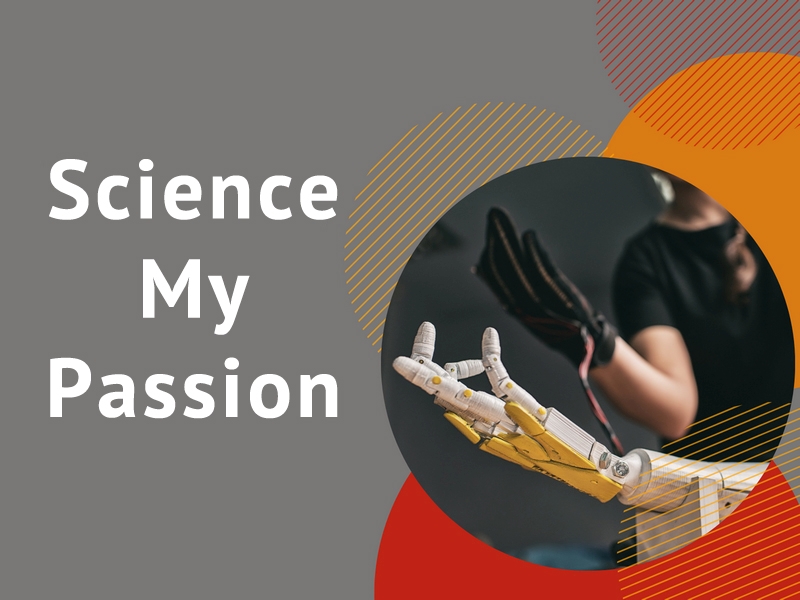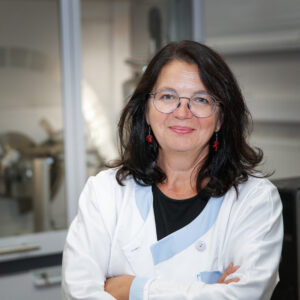SCIENCE | MY PASSION
According to the definition taken from the Polish Language Dictionary, science is complete human knowledge arranged into a system of problems, but also a set of ideas that constitute a systematic whole and comprise a specific research field.
Science is also activity: learning and teaching.
Please read the “Science | My Passion” series, where our researchers present their work and show that science and research process can really draw us in.
MAŁGORZATA KAROLUS, PhD, DSc, Associate Professor
Institute of Materials Engineering
Don’t waste your time on the Internet and TV!
When I think about the answer to the question “Who has instilled in me a passion for science and a curiosity of the world?”, after some thought I answer “my parents and … television”.
My parents understood the importance and value of education in life, so they made sure that my sister and I were thoroughly educated. They awakened our curiosity of the world, including science, history, culture and art. They did not force interests or degree programmes on us. Quite the contrary, they encouraged us to make our own choices, and over time, we enjoyed our subsequent experiences and successes together.
But what does television have to do with awakening a passion for knowledge and science? Well, a lot, actually. Namely, in the 1970s and 1980s, the Polish Public Television offered a very rich selection of educational programmes regarding various fields of knowledge, addressed to children and teenagers of all ages. Iconic programmes, such as: “Zwierzyniec” (Menagerie) led by the invaluable animal lover Michał Sumiński, who showed the beauty and richness of the flora and fauna of our Polish forests. “Klub Sześciu Kontynentów” (Six Continents Club) led by Ryszard Badowski, who hosted in his “Kawiarenka pod Globusem” (Café under the Globe) such travellers as Stanisław Szwarc-Bronikowski, Jerzy Kukuczka, Wanda Rutkiewicz, Leonid Teliga, Tony Halik and Krzysztof Baranowski. “Zrób to sam” (Do It Yourself), Adam Słodowy’s original TV programme, which showed step by step instructions on how to make bird feeders, toy cars, lamps and hundreds of different (505 episodes aired!) objects and playthings with the use of items present in every household, such as planks, thread spools or matchboxes. Another programme, innovative in its form and aimed at all viewers interested in technical news from the country and the world, was “SONDA“, hosted by Zdzisław Kamiński and Andrzej Kurek.
Just like many of my peers became interested in biology after watching “Zwierzyniec” and in geography after watching television travels (today we would say “virtual travels”) with the “Klub Sześciu Kontynentów“, my interest in physics and technology was a simple consequence of hours spent constructing Adam Słodowy’s projects and following scientific discoveries with Zdzisław Kamiński and Andrzej Kurek. After many dilemmas, my final choice of degree programme was Physics at the Faculty of Mathematics, Physics and Chemistry (as of 2019 – Faculty of Science and Technology) at the University of Silesia in Katowice.
The people we meet on our way and the events we take part in are an important element that shapes each one of us, especially during our school and university years. I have been very lucky in this regard. I met many good university lecturers during my studies, but what I valued most was the opportunity to participate in classes and seminars taught by Prof. August Chełkowski. Prof. Chełkowski conducted his classes in the form of discussions, asked us questions and suggested problems to solve, taught us to think independently and to look for answers in scientific literature. Today, in retrospect, I believe that it was the Professor, back then the Head of the Department of Solid State Physics, who first awakened in me the desire to learn about the structure and properties of matter. The topics of our MSc theses were also often related to recent scientific discoveries. This was also the case with my diploma thesis written under the supervision of Prof. Andrzej Ślebarski. It concerned the research of high-temperature oxide superconductors, for the discovery of which the Nobel Prize was awarded to J.G. Bednorz and K.A. Müller in 1987. In my final, fifth year of studies, I began my adventure with crystallography and X-ray diffraction as well as the research of the structure of materials, which continues to this day. I was first employed as a trainee assistant and then promoted to assistant at the Institute of Physics and Chemistry of Metals at the Faculty of Technology of the University of Silesia in Katowice. Once again, I was lucky. During the practice and my assistance in the Institute, I participated in lectures and classes held by extraordinary educators specialised in crystallography, diffraction theory and XRD methods of structural analysis – Professors Zbigniew Bojarski and Eugeniusz Łągiewka. It was also then that I started partaking in classes in various schools and participating in domestic and international conferences where I gained knowledge about the methods of study, materials and their features. On the threshold of my scientific career, I met the biggest stars and authorities in the crystallography and diffraction fields, such as Hugo Rietveld, Ray Young, A. Le Bail, and many others. Over the years, I had the privilege and pleasure to meet, talk to, or only listen to Nobelists, such as the aforementioned Johannes Bednorz (Nobel Prize winner in 1987), Sir Harold W. Kroto (Nobel laureate in the chemistry field in 1996 for the discovery of fullerene), Rudolf L. Mössbauer (Nobel Prize in 1961 in the science field), Herbert A. Hauptman (Nobel Prize in 1985 in the chemistry field), or Dan Szechtman (Nobel laureate in 2011 in the chemistry field for the discovery of quasicrystals). This kind of base gives great motivation to expand one’s own abilities, search for new visions and solutions, and educate new generations.
Another element of scientific and educational work at a university is science communication and spreading results of research. The received results of research experiments and analyses are presented in articles and books published in scientific magazines and publishing companies of an international reach, during lectures on conferences held domestically and abroad where it is possible to meet and have a conversation with the greatest scientists of the world. An additional, non-scientific attraction of such business trips is, without any doubt, the pleasure of meeting new people and their beliefs, traditions, as well as the culture and art of the visited countries and regions. Working with outreach activities, which popularises knowledge and science among the society, gives a lot of satisfaction, as well. Participation in various activities for children, teens, and adults, such as lectures on popular science, workshops and displays of scientific experiments organised during festivals, such as the already commonly known and internationally successful Silesian Science Festival in Katowice, periodic festivals with long history, like Pi Day, organised by the Faculty of Science and Technology of University of Silesia in Katowice (formerly organised by the Faculty of Mathematics, Science and Chemistry of University of Silesia; in 2022 XVI edition of the Festival was held) or brand new ones, such as “Granatowe Góry” Jerzy Pilcha Word Festival, held for the first time in 2021 in Wisła. Such meetings are always immeasurably inspiring both for the hosts and the spectators.
Today I work at the Institute of Materials Science and Engineering at the Faculty of Science and Technology of University of Silesia in Katowice, where we educate future generations of Master’s degree engineers and students who specialise in materials and their functions, research methods and their use in the industry, for example in production, manufacturing, or quality control of materials technological processes. In a comedic sense I could say I had started my scientific adventure with my fascination with physics given to me by the TV programme “SONDA” and I have been finishing it with the practical use of the knowledge and abilities according to the main concept of the TV programme “Zrób to sam”.
Superb lecturers whom I still listen to eagerly to this day; interesting research topics which I pursue; curious and involved students and young people whom I try to give over the desire to expand knowledge and search new possibilities – all of those are the components of the image of my current scientific and educational work at University of Silesia in Katowice. And looking back at the many, many years of this work I can say that it pays off to sacrifice the time and most of life for it…
Thank you for reading this entire post







